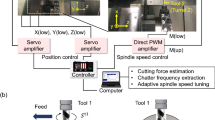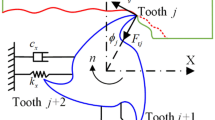Abstract
This paper presents how real-time chatter prevention can be realized by feedback of acoustic cutting signal, and the efficacy of the proposed adaptive spindle speed tuning algorithm is verified as well. The conventional approach to avoid chatter is to select a few appropriate operating points according to the stability lobes by experiments and then always use these preset cutting conditions. For most cases, the tremble measurement, obtained by accelerometers or dynamometers, is merely to monitor spindle vibration or detect the cutting force, respectively. In fact, these on-line measures can be more useful, instead of always being passive. Furthermore, most of these old-fashioned methodologies are invasive, expensive, and cumbersome at the milling stations. On the contrary, the acoustic cutting signal, which is fed into the data acquisition interface, Module DS1104 by dSPACE, so that an active feedback loop for spindle speed compensation can be easily established in this research, is non-invasive, inexpensive, and convenient to facilitate. In this research, both the acoustic chatter signal index (ACSI) and spindle-speed compensation strategy (SSCS) are proposed to quantify the acoustic signal and compensate the spindle speed, respectively. By converting the acoustic feedback signal into ACSI, an appropriate spindle speed compensation rate (SSCR) can be determined by SSCS based on real-time chatter level. Accordingly, the compensation command, referred to as added-on voltage (AOV), is applied to actively tune the spindle motor speed. By employing commercial software MATLAB/Simulink and DS1104 interface module to implement the intelligent controller, the proposed chatter prevention algorithm is practically verified by intensive experiments. By inspection on the precision and quality of the workpiece surface after milling, the efficacy of the real-time chatter prevention strategy via acoustic signal feedback is further examined and definitely assured.
Similar content being viewed by others
References
Lange JH, Abu-Zahra NH (2002) Tool chatter monitoring in turning operations using wavelet analysis of ultrasound waves. Int J Adv Manuf Technol 20(4):248–254
Khalifa OO, Densibali A, Faris W (2006) Image processing for chatter identification in machining processes. Int J Adv Manuf Technol 31(5–6):443–449
Tobias SA (1965) Machine tool vibration. Blackie, London
Koenigsberger F, Tlusty J (1967) Machine tool structures—vol. I: stability against chatter. Pergamon, New York
Delio T, Tlusty J, Smith S (1992) Use of audio signals for chatter detection and control. J Eng Ind 114:146–157
Soliman E, Ismail F (1998) A control system for chatter avoidance by ramping the spindle speed. J Manuf Sci Eng 120:674–683
Altintas Y, Budak E (1995) Analytical prediction of stability lobes in milling. CIRP Ann 44(1):357–362
Faassen RPH, Wouw NVD, Oosterling JAJ, Nijmeijer H (2003) Prediction of regenerative chatter by modeling and analysis of high-speed milling. Int J Mach Tools Manuf 43:1437–1446
Solis E, Peres CR, Jimenez JE, Alique JR, Monje JC (2004) A new analytical-experimental method for the identification of stability lobes in high-speed milling. Int J Mach Tools Manuf 44:1591–1597
Merdol SD, Altintas Y (2004) Multi frequency solution of chatter stability for low immersion milling. J Manuf Sci Eng 126:459–466
Bayly PV, Schmitz TL, Stepan G, Mann BP, Peters DAP, Insperqer T (2002) Effects of radical immersion and cutting direction on chatter instability in end-milling. Manufacturing Engineering Division 13:351–363
Shorr MJ, Liang SY (1996) Chatter stability analysis for end milling via convolution modeling. Int J Adv Manuf Technol 11(5):311–318
Morgan G, Cheng RQ, Altintas Y, Ridgway K (2007) An expert troubleshooting system for the milling process. Int J Mach Tools Manuf 47:1417–1425
Weingaertner WL, Schroeter RB, Polli ML, Gomes JDO (2006) Evaluation of high-speed end-milling dynamic stability through audio signal measurements. J Mater Process Technol 179:133–138
Schmitz TL, Medicus K, Dutterer B (2002) Exploring once-per-revolution audio signal variance as a chatter indicator. Mach Sci Technol 6(2):215–233
Ismail F, Ziaei R (2002) Chatter suppression in five-axis machining of flexible parts. Int J Mach Tools Manuf 42:115–122
Author information
Authors and Affiliations
Corresponding author
Rights and permissions
About this article
Cite this article
Tsai, NC., Chen, DC. & Lee, RM. Chatter prevention for milling process by acoustic signal feedback. Int J Adv Manuf Technol 47, 1013–1021 (2010). https://doi.org/10.1007/s00170-009-2245-y
Received:
Accepted:
Published:
Issue Date:
DOI: https://doi.org/10.1007/s00170-009-2245-y




